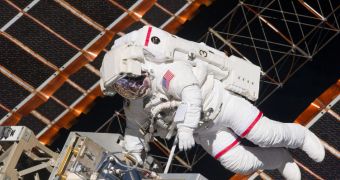Two astronauts from space shuttle Endeavour's crew exited the International Space Station (ISS) early today, in order to conduct the third of four planned extravehicular activities for the STS-134 mission.
This is the orbiter's last flight, and the six-astronaut crew has a lot of chores to tackle. The fourth EVA will be last conducted by a shuttle crew. During the last shuttle mission ever, which will be carried out by Atlantis in July, there are no planned spacewalks.
The third EVA began earlier today, May 25, at 1:43 am EDT (0543 GMT), and is being conducted by NASA astronauts Andrew Feustel and Michael Fincke. NASA mission planners say that the activity is scheduled to last for about 6 hours and 30 minutes.
Both spacewalkers are EVA veterans. This is the sixth time Feustel steps out of the ISS to perform such an activity, while Fincke is at the seventh spacewalk of his career, Space reports. The ISS is currently at an altitude of 220 miles (354 kilometers).
“It's great to be back outside. It's the most beautiful planet in the Universe,” Fincke said at the beginning of the spacewalk. “Nice view, isn't it?” Feustel replied. The two then focused on the chores they have to perform today.
First, they need to finish some tasks that were left uncompleted during the first STS-134 EVA. Astronauts that carried out that EVA needed to return to the ISS early on account of a space suit glitch.
Feustel and Fincke need to complete work on an external wireless antenna system, and will then move to perform a series of maneuvers that are meant to reduce redundancy in a power system. The latter provides electricity to the Russian segment of the ISS.
In addition, the two also need to attach a new grapple fixture to the exterior wall of the Russian-built Zarya control module. This will extend the reach of the station's robotic arm, which is essential to performing exterior operations.
With the new fixture, Canadarm-2 will be able to attach itself to that module, and then use its other end in a similar manner to how it now uses the current one. When this becomes possible, the robotic arm will cover a much larger portion of the ISS.
Endeavour has reached the middle of its stay on the orbital lab. It docked to the orbital facility on May 18, following a successful May 16 launch from the Kennedy Space Center (KSC), in Florida.
According to mission planners at NASA, the spacecraft will separate from the ISS on May 29, and land at the KSC on June 1. After that time, it will be decommissioned, and sent to the California Science Center, in Los Angeles, for a permanent display, Space reports.

 14 DAY TRIAL //
14 DAY TRIAL //